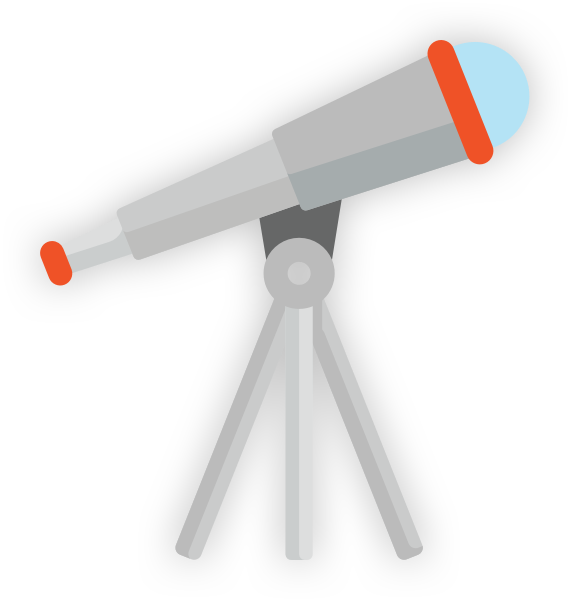Ecosystems
Feeding Relationships
Water Cycle
Many materials cycle through the natural world, being used for a time by an organism and then being recycled and reused after they are excreted from the body, consumed by another creature or released by decay after death.
Water is passed through living (biotic) and nonliving (abiotic) parts of an ecosystem in a continuous cycle. This begins with the large store of water in the world’s oceans and larger lake systems. These are heated by the sun and this causes evaporation. The moisture travels in the atmosphere and in the right conditions condenses to clouds to give rian, sleet, snow and mists. These forms of precipitation bring water to the continents. Some of this will run off the land and form rivers and lakes that flow back to the sea. Some will be absorbed by plants and returned to the atmosphere via transpiration. Some water will be taken in by animals directly as water or via food and eventually excreted as vapour in the breath or via urination.
There is continuous cycling of water through the biotic and abiotic parts of the ecosystem or on a larger scale the biosphere that contains all the part of the living and non-living sections of the whole planet.
Carbon Cycle
Carbon is an essential part of all organism on Earth, all the biological compounds (organic chemistry) ar made of carbon based chains and rings. The carbon cycle is an important part of supplying this essential element to organisms, it is also important in the maintenance of the Earth’s atmospheric temperature.
There are two major carbon stores in the biosphere, the CO2 in the atmosphere and the CO2 dissolved in the oceans. With the exception of combustion, the process that cycle CO2 between the atmosphere and the organisms and rocks on land, also occur in the oceans. In addition in the oceans there is the process of sedimentation, this is where dead organisms carry their carbon to the ocean floor. CO2 enters the oceans by the process of dissolving. As the CO2 levels in the atmosphere increase so does the amount in the oceans.
CO2, in the atmosphere can be extracted by photosynthesis. This is then passed on via consumption to animals. Both plants, animals and microbes during decay return CO2 to the atmosphere via respiration. The amount of CO2 taken in by photosynthesis has been balanced by the return via respiration for millions of years. The addition of CO2 from fossil fuels via combustion is adding CO2 back to the atmosphere that has been locked away for over 650 million years. This is why the CO2 levels in the air are rising.
Nitrogen Cycle
Nitrogen is recycled and reused in a cycle that involves bacteria to convert the nitrogen stored in dead material and return it to the soil so that plants can reuse it and pass it along via consumption into the ecosystem. Nitrogen is essential for making proteins in all organisms.
Although 79% of the atmosphere is nitrogen, it is in an inert form. Most living organisms cannot use it in this form to make proteins. The main accessible nitrogen is found in the soil as nitrates (NO3), this is take up by plants and used to make plant proteins. Plant proteins are passed on to animals when they are consumed and move along the food chain in this way.
When plants and animals die, or when animals excrete nitrogen rich materials like urea and feces, bacteria convert the proteins to ammonia (NH3). Ammonia is a very toxic compound and is converted back to nitrates by nitrifying bacteria. These are found naturally in the soil.
Nitrogen from the atmosphere can enter the soil as nitrates in two ways.
- Nitrogen fixing bacteria living in the soil and the root nodules of legumes can convert N2 into NO3. These bacteria help to keep the soil fertile by increasing the nitrates available to plants. Organic farms often plant legumes to help with the process rather than using artificial fertilizers.
- Lightning causes nitrogen and oxygen to bond making nitrates in the atmosphere, these dissolves in the rain and fall to earth. This is a very important part of the nitrogen cycle as lightning occurs all the time somewhere on earth, even high up in the atmosphere where it is unobserved by humans.
Nitrogen can also be fixed into nitrates by humans in a process known as the Haber process, this is used to make nitrate rich fertilizers for farms.
The bacteria that fix nitrogen naturally in the soil will only do this if the soil has plenty of oxygen. In a soil with very little oxygen, such as a water logged soil, these same bacteria can reverse the process to get the oxygen from the nitrates for respiration, this results in them taking nitrogen from the soil and returning it to the atmosphere. This makes the soil less fertile.
Water Cycle
A simple feeding relationship can be shown as a food chain. This indicates the flow of energy and nutrients from one creature to another in a simple chain. At each step in the chain only 10% of the energy is passed on, this means that chains are normally limited to 3 or 4 steps. After that there is too little energy left in the system to sustain another creature.
This can be written as:
Sun _→ _grass _→ _rabbit _→ _fox
Note that the arrows indicate the direction of flow of both energy and nutrients along the chain.
